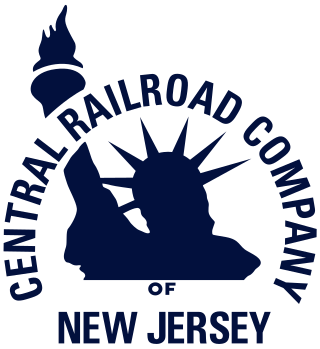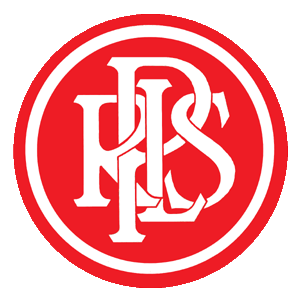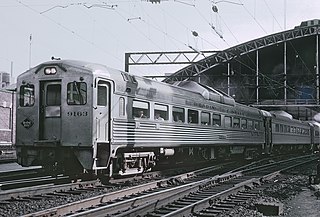
The Reading Company was a Philadelphia-headquartered railroad that provided passenger and freight transport in eastern Pennsylvania and neighboring states that operated from 1924 until its acquisition by Conrail in 1976.

The Central Railroad of New Jersey, also known as the Jersey Central, Jersey Central Lines or New Jersey Central, was a Class I railroad with origins in the 1830s. It was absorbed into Conrail in April 1976 along with several other prominent bankrupt railroads of the Northeastern United States.

The Pennsylvania-Reading Seashore Lines was a railroad that operated in South Jersey in the 20th century. It was created in 1933 as a joint consolidation venture between two competing railroads in the region: the Pennsylvania Railroad and the Reading Company.

The SEPTA Regional Rail system is a commuter rail network owned by SEPTA and serving the Philadelphia metropolitan area. The system has 13 branches and more than 150 active stations in Philadelphia, Pennsylvania, its suburbs and satellite towns and cities. It is the sixth-busiest commuter railroad in the United States, and the busiest outside of the New York, Chicago, and Boston metropolitan areas. In 2016, the Regional Rail system had an average of 132,000 daily riders and 118,800 daily riders as of 2019.

The Center City Commuter Connection (CCCC), commonly referred to as "the commuter tunnel", is a passenger railroad tunnel in Center City, Philadelphia, Pennsylvania, United States, built to connect the stub ends of the two separate regional commuter rail systems, originally operated by two rival railroad companies: the Pennsylvania Railroad and the Reading Company. All of the SEPTA Regional Rail lines except for the Cynwyd Line pass completely through the four-track tunnel, which contains two underground stations, Suburban Station and Jefferson Station, and the above-ground upper-level concourse for the east–west commuter lines serving 30th Street Station.
Schuylkill River Passenger Rail is a proposed passenger train service along the Schuylkill River between Philadelphia and Reading, Pennsylvania, with intermediate stops in Norristown, King of Prussia, Phoenixville, and Pottstown.

Ivy Ridge station is a SEPTA Regional Rail station in Philadelphia, Pennsylvania. Located at Umbria Street and Parker Avenue in Northwest Philadelphia, it serves the Manayunk/Norristown Line. The initial station was built in a minimalist design similar to that of Elm Street, Norristown. The current station has a 204-space parking lot. In FY 2013, Ivy Ridge station had a weekday average of 602 boardings and 582 alightings.
The New Hope Railroad, formerly and colloquially known as the New Hope and Ivyland Railroad, is a shortline and heritage railroad located in New Hope, Pennsylvania. Today, the railroad operates both steam and diesel powered locomotives and is an associate member of NORAC.
The North Pennsylvania Railroad was a railroad company which served Philadelphia, Montgomery County, Bucks County and Northampton County in Pennsylvania. It was formed in 1852, and began operation in 1855. The Philadelphia and Reading Railway, predecessor to the Reading Company, leased the North Pennsylvania in 1879. Its tracks were transferred to Conrail and the Southeastern Pennsylvania Transportation Authority (SEPTA) in 1976.

The Reading Blue Mountain and Northern Railroad, sometimes shortened to Reading and Northern Railroad, is a regional railroad in eastern Pennsylvania. Its headquarters is in Port Clinton. The RBMN provides freight service on 400 miles (640 km) of track. Its mainline consists of the Reading Division between Reading and Packerton and the Lehigh Division between Lehighton and Dupont. Its main freight cargo is anthracite coal.
The Lebanon and Tremont Branch of the Philadelphia & Reading Railroad was a railroad line in Lebanon and Schuylkill County, Pennsylvania, built to tap the coal fields in the West End of Schuylkill County and send coal southward to Lebanon.

The Crusader was a 5 car stainless steel streamlined express train that ran on a 90.3-mile (145.3 km) route from Philadelphia's Reading Terminal to Jersey City's Communipaw Terminal, with a ferry connection to Lower Manhattan at Liberty Street. The Reading Railroad provided this service in partnership with the Central Railroad of New Jersey (CNJ), in which it was the majority owner of capital stock. Trains including the Crusader ran on Reading Railroad tracks from Reading Terminal in Philadelphia to Bound Brook, NJ, where they continued on CNJ tracks to Communipaw Terminal in Jersey City. Passengers then left the train and walked aboard the ferry or boarded busses that loaded onto the ferry. Introduced in 1937, the Crusader service declined during the 1960s, and the name was ultimately dropped in 1981.
The West Jersey and Seashore Railroad (WJ&S) was a Pennsylvania Railroad subsidiary in the U.S. state of New Jersey with a connection to Philadelphia. It was formed through the merger of several smaller roads in May 1896. At the end of 1925 it operated 379 miles (610 km) of road on 717 miles (1,154 km) of track; that year it reported 166 million ton-miles of revenue freight and 332 million passenger-miles. The railroad became part of Pennsylvania-Reading Seashore Lines in 1933.

The Warminster Line is a route of the SEPTA Regional Rail commuter rail system. It serves stations between its namesake town, Warminster, and Center City Philadelphia. Half of the route is shared by other lines, including the Lansdale/Doylestown Line, West Trenton Line, Fox Chase Line, Chestnut Hill East Line, and Manayunk/Norristown Line. All trains continue as part of the Airport Line. With the exception of several rush hour trains which terminate at William H. Gray III 30th Street Station, as well as Thorndale and Newark, DE.

The West Trenton Line is a SEPTA Regional Rail service connecting Center City Philadelphia to the West Trenton section of Ewing Township, New Jersey. With around 12,000 riders every weekday, it is the third busiest line in the SEPTA Regional Rail network.

The Lansdale/Doylestown Line is a SEPTA Regional Rail line connecting Center City Philadelphia to Doylestown in Bucks County, Pennsylvania. Until 1981, diesel-powered trains continued on the Bethlehem Branch from Lansdale to Quakertown, Bethlehem, and Allentown. Restored service has been proposed, but is not planned by SEPTA. The line is currently used by the East Penn Railroad, serving Quakertown's industrial complexes and distribution centers. With around 17,000 daily riders every weekday in 2019, it is the second busiest line in SEPTA's Regional Rail network.

The Manayunk/Norristown Line is a commuter rail service in Southeastern Pennsylvania between Center City Philadelphia and Norristown, and one of the 13 lines in SEPTA's Regional Rail network. It has the fourth highest ridership and the highest operating ratio (58%) on the SEPTA Regional Rail network.

The Chestnut Hill East Line is a route of the SEPTA Regional Rail system. The route serves the northwestern section of Philadelphia with service to Germantown, Mount Airy, and Chestnut Hill. It is one of two lines that serve Chestnut Hill, the other one being the Chestnut Hill West Line. The line is fully grade-separated.

The Warminster Branch is a railway line in the state of Pennsylvania. It runs 8.3 miles (13.4 km) from a junction with the SEPTA Main Line just north of Glenside to Warminster, where it meets the New Hope Railroad. It was originally built by the North East Pennsylvania Railroad, a subsidiary of the North Pennsylvania Railroad, between 1872 and 1874. It was part of the Reading Company system from 1879 until 1976. Today it is owned by SEPTA and hosts Warminster Line commuter rail service. A later extension of the branch to New Hope, Pennsylvania is now the New Hope Railroad heritage railway.

The Pottsville Line was a commuter rail service in the Delaware Valley, connecting Pottsville, Reading, and Pottstown with Philadelphia. It was the last vestige of passenger service on the former Reading main line. The service lasted into the SEPTA era and was discontinued in 1981. SEPTA continues to operate Manayunk/Norristown Line commuter trains between Philadelphia and Norristown.
















